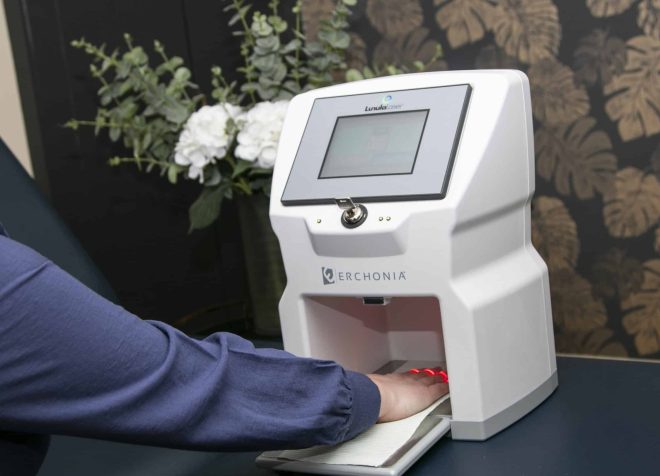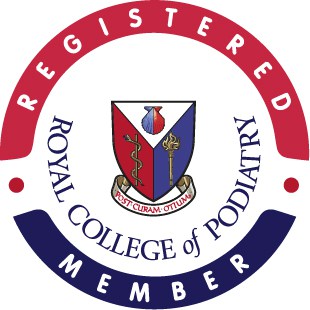Lunula Laser For Fingernail Fungal Infection
Recover Your Beautiful, Healthy Fingernails
Although nail fungus is a common condition that affects toenails, it can also develop in your fingernails.
Medically known as Onychomycosis, a fungal nail infection may cause your fingernails to develop a yellowish-brown appearance and become thick, fragile, or cracked. The nail may also become separated from the nail bed.

What causes a fingernail fungal infection?
Fungal nail infections are caused by many different types of fungi that live in the environment. The most common type is called dermatophyte. Others include yeast and moulds.
When foreign fungal organisms enter the body and your immune system is compromised, these fungi grow, spread and invade the tissue, causing a localised infection. For example, small cracks in your nail or the surrounding skin can allow these germs to enter your fingernails and develop nail fungus. Onychomycosis is a highly contagious condition that, if not treated effectively, will keep recurring and spreading from nail to nail. Therefore, if your fingernails show any discolouration or damage, it is highly advised that you seek professional help to treat them immediately. Once the infection is in the nail, it can cause the surrounding skin to become infected, leading to the deterioration of tissue and, as a result, bacterial infection, which can turn quite serious.Lunula laser for fingernail fungal infection
Everybody loves beautifully manicured hands. However, regular use of nail polishes and gels, such as Shellac, Gelish, and Axxium, can cause significant weakness in the nails and make them prone to developing fungal infections.
If, when removing your nail polish, you see white spots, yellow discolouration, or thickening of the nail, you may have a fungus forming. It’s essential to stop covering up with more polish and seek professional help. Unfortunately, nail polishes prevent your nails from breathing and can trap any moisture on the nail before painting them, creating the perfect environment for fungus to grow. At Walk This Way Podiatry, we can help you recover your beautiful fingernails with Lunula Laser.What is Lunula Laser treatment?
Lunula is a non-thermal, cold laser designed to attack specific cells within a fungus to kill it off. As well as weakening and eradicating the nail fungus, Lunula laser treatment has proven to improve blood circulation and oxygen delivery and reinforce the immune system, promoting new, healthy nail growth.
What makes Lunula Laser treatment safe and effective?
Lunula laser uses the principles of photochemistry — a process that uses the cells in your body to produce different types of chemicals — to attack and break through the spores of the fungus.
The living cells in your body require chemical energy to survive. In fact, 90% of the energy needed for the cells to function and live is produced by working organelles called Mitochondria. Without Mitochondria, energy cannot be converted to power the cells, leading to worn-down, malfunctioning cells. Lunula laser treatment targets the Mitochondria in the fungal cell, eliminating its capacity to release and convert the energy the cell needs to survive. The laser light attacks the fungus living under your fingernails without causing damage to the nail or surrounding skin.How does Lunula cold laser work?
Lunula Laser uses two different wavelengths of light — 405nm (violet) and 635nm (red) — to attack the Mitochondria and kill the fungal cell, effectively treating Onychomycosis.
When activated, the Lunula Laser device causes the two light beams to rotate. The violet beam is antimicrobial, and its function is to target the Mitochondria to trigger a reaction called oxidative stress. When in contact with the infected fingernail, it activates a photochemical response producing Reactive Oxygen Species chemicals (specifically Hydrogen Peroxide), which cause damage to the Mitochondrial and fungal cell membrane. These chemicals are then converted to Hydrogen Peroxide, a natural antiseptic, which kills off the fungus that lives in and under the nail, causing irreversible cell damage. The red beam then works with the violet beam by activating another photochemical reaction, dilating localised blood vessels. This process brings your blood supply down to the area, triggering your body’s natural immune response to release white blood cells to help fight the infection. As a result, your body will start regenerating new tissue, promoting the nail’s growth. The combination of these two lights works to eradicate the nail fungal infection and boost healing.What happens during Lunula Laser fingernail treatment?
Firstly, you’ll be invited to have an assessment to determine your suitability for the treatment and assess the severity of the infection and the number of sessions needed.
If you qualify for the treatment, we will proceed to prepare your nails, removing any debris or dirt from the surface. We will also take a few photographs of your hands to monitor the progress during the treatment. During the treatment, you’ll be asked to insert your hands inside a self-operated device, which is then activated and runs for a period of 12 minutes. Lunula’s unique feature is that the device delivers the light as a line-generated beam, maximising the amount of area on the nail that can receive the treatment. This system enables the line-generated beam to reach the fungal pathogen regardless of where it resides, within a dystrophic nail or along the nail bed and root.How many Lunula Laser treatments are you likely to need?
The number of treatments needed will vary depending on the severity of the fungal nail infection.
Moderate infections usually require four 12-minute-session treatments. However, a course of 6-8 treatments may be necessary for more severe infections. Our Podiatrist will discuss the number of sessions your fingernails need during your initial assessment.How effective is Lunula Laser treatment?
Lunula cold laser clinical trial results demonstrate that 89% of patients respond to Lunula laser with 6.1mm of clear, healthy nail growth after six months. Lunula cold laser technology is also FDA Approved and CE Marked.







